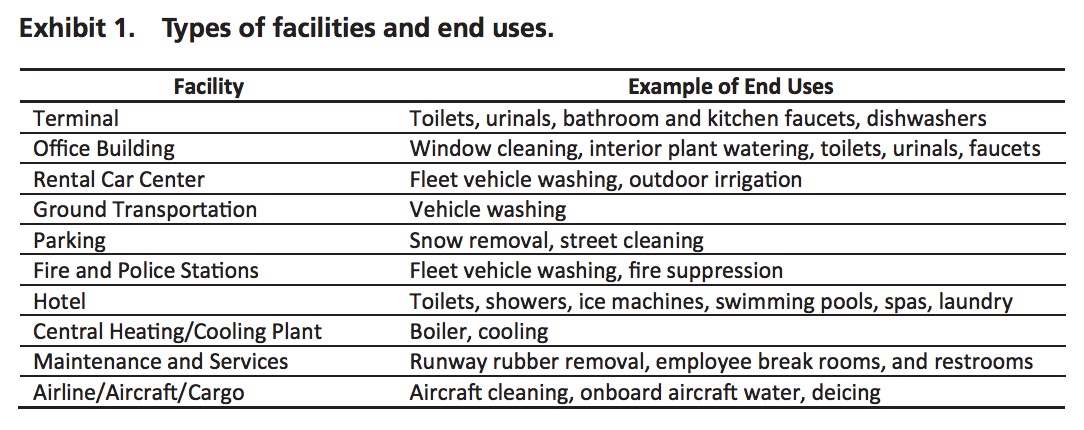AIRPORT COOPERATIVE RESEARCH PROGRAM
Introduction
Secure and dependable water resources are essential to the successful operation of any airport. Water is needed for maintaining food and hospitality concessions within the airport complex, operating cooling towers and basic amenities within the terminal area, cleaning and maintaining aircraft and rental cars, and maintaining grassed areas and landscapes. Water efficiency efforts are becoming more critical, even in parts of the country that were historically “water rich,” because of the following:
- Climatic changes increasing the probability of variations in water availability from year to year
- Increasingly complex regulations affecting the availability and cost of potable water
- The continued growth and expansion of urban centers
These issues, combined with the expected increase in water demand at airports to accommodate growth in air travel, accentuate the need for comprehensive guidance on developing and implementing a water efficiency program for airports. Despite this need, there is no central resource for water efficiency programs, and there remains a general lack of awareness of water conservation issues and approaches.
This guidebook is designed to help airports evaluate their water use and develop a water efficiency program. To support the development of this guidebook, the research team conducted interviews at 15 airports across the United States. The team visited six of these airports and collected detailed information about their water use. These interviews and site visits provided insight into water use at airports, factors that motivate water efficiency programs, and challenges facility managers may face in evaluating water use at their airports.
Why Is Water Efficiency Important?
Despite improvements in the efficiency of common fixtures such as toilets and showerheads, demand continues to grow for clean and safe water from increasingly stressed water resources. In particular, drought conditions combined with high peak water demand—particularly during the summer season—further stretch the system. As major consumers of water, airports have an obligation to be responsible environmental stewards in the community by increasing the efficiency of their water use and decreasing the amount of energy they spend to heat and pump that water. These changes can lower airports’ costs, improving the financial as well as the environmental sustainability of their operations.
When airports expand or renovate facilities, they often are able to incorporate water efficiency into these projects as part of sustainable design. Some airports, however, are finding their expansion plans threatened by lack of available water resources or uncertainty about how the changes will expand their facilities’ water footprint. (An airport’s water footprint is the amount of fresh water it uses to provide its service.) Implementing water efficiency practices can reduce costs and achieve a lower water footprint. For example, improving water efficiency reduces costs associated with both purchasing potable water and discharging water into wastewater systems. Pressure experienced by airports to lower their water use may come from the following:
- Internal goals (e.g., saving money, improving sustainability)
- External agencies (e.g., local regulations, water utilities)
- Members of the public who expect their community institutions to be sustainable stewards and to share in the efforts to deal with droughts and water shortages
Factors Affecting Airport Water Management
No two airports are completely alike when it comes to water management; each faces a unique set of challenges. Regional climate is a critical factor, as are the size and type of the airport. Local, regional, state, and federal water laws differ significantly, from water rights issues to requirements for water conservation regulations on new and existing facilities. Every airport either draws water from a separate drinking water system, or is itself a regulated drinking water system. The management of airports is complicated and often fractured. Some are privately owned; some are publicly owned; and some are hybrid enterprises. Similarly, the functions of airports vary greatly, including commercial service, cargo service, reliever, general aviation, private, military, aircraft maintenance and repair, and more. Some facilities are generations old, while others are new and modern; some facilities are sprawling and complex, while others are compact and simple. Airports generally have a steady demand for water, though it obviously varies throughout the day, week, and year and can have peak periods depending on the airport, its location, and use. These differences highlight the need for every airport to develop water efficiency programs with priorities and water use targets appropriate to their specific needs.
One way to characterize water use at an airport is by the type of building or facility in which it is used. Types of airport facilities are shown in Exhibit 1. Within each facility, the airports have several end uses for water, including toilets, faucets, cooling towers, deicing, and fire suppression.
At the airports visited during the development of this guidebook, most of the water was used in the following facilities:
- Terminals
- Rental car centers
Download full version (PDF): Water Efficiency Management Strategies for Airports
About the Airport Cooperative Research Program
www.trb.org/ACRP
The Airport Cooperative Research Program (ACRP) is an industry-driven, applied research program that develops near-term, practical solutions to problems faced by airport operators. ACRP is managed by the Transportation Research Board (TRB) of the National Academies of Sciences, Engineering, and Medicine and is sponsored by the Federal Aviation Administration (FAA). The research is conducted by contractors who are selected on the basis of competitive proposals.
Tags: ACRP, AIRPORT COOPERATIVE RESEARCH PROGRAM, airports, National Academies, Transportation Research Board, TRB, TRB of NA







 RSS Feed
RSS Feed